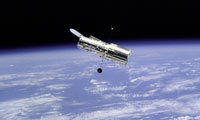Hubble Space Telescope spends 18 years on Earth's orbit
On April 24 of the current year 59 new images were published in the beginning of the 19th flight on the near-earth orbit. The images were taken by the Hubble space observatory. The set of images is the most voluminous “work” of the telescope throughout the whole history of its flights. The Hubble photographed galaxies at different stages of changes. The images show the variety of new and unusual fusion forms that remind of a flying owl or a tooth brush. The fusion of galaxies turned out to be a usual thing in the Universe. Our galaxy Milky Way contains debris of extinct star systems and it will be absorbed by the Great Nebula in Andromeda in a couple of billion years, some scientists consider. The collision of star systems may last for several million years.

A great contribution to this and many other discoveries was the Hubble, a unique device that functions continuously on the orbit for about two decades. It was named after Edwin Hubble (1889-1953) who studied galaxies.
The project of the orbiting telescope was brought forward in 1946 by US astrophysicist Lyman Spitzer and it cost its creators 2.5 billion dollars. Originally, the project was estimated at six billion dollars. The Hubble was initiated in 1978 as a joint project of NASA and the EKA company. Its launch was due in 1983, later it was postponed to 1986. On January 26 the Challenger catastrophe suspended shuttle flights to the orbit. The telescope remained on earth for another four years.
The major part of any reflecting telescope is a reflecting mirror. The mirror of the Hubble is 2.4 meters in diameter and is produced from special glass with an ultralow expansion coefficient. The aluminum reflecting surface, 75 nanometers thick, protects a layer of magnesium fluoride, 25 nanometers thick. The Perkin Elmer produced the mirror and used the up-to-date, though untested, technologies. The Kodak produced another mirror in a traditional way as insurance. The Kodak mirror was unnecessary and became an exhibit in the museum of Smithson’s Institute.
At that time the Hubble preparations were over and it was to be lofted to the orbit four years ago, meanwhile, its details were kept in a special room with pure atmosphere, which made the project much more expensive. Finally, on April, 24 1990 the Discovery shuttle (STS-31 mission) delivered the device to the place.
The Perkin Elmer had problems with mirror production. Within the first weeks of exploitation they discovered a serious defect. The Hubble could not gain the set focus and the image was of low quality. The examination showed that the assembly was erroneous before polishing. After exchanging accusations the producing company and NASA set up thinking over the solution. The Hubble was initially made for orbiting repair. Some experiments were put off and some experiments aimed at other Hubble facilities yielded numerous scientific discoveries.
The orbiting telescope was repaired by the Endeavour crew in 1993. The spacewalk was one of the most demanding on the orbit. NASA training took astronauts eleven months. The repair took ten days and five long spacewalks. The efforts were worth while: the telescope images grew clear and better in quality. Further developments and maintenance were in 1997, 1999 and 2002.
The oversight over the orbiting observatory is carried out by the Goddard Space Flight Center, with NASA being responsible for maintenance and the special The Space Telescope Science Institute being in charge of scientific research and astronomers’ access to data. NASA was eager to control the orbiting observatory, but after debates with scientists it was decided to hand the control over to academic constitutions.
After the Columbia catastrophe on March 1 of 2003 (the crew died in shipwreck due to the damaged heat-resistant coating), the next Hubble repair was postponed for uncertain period. The telescope working condition was poor and nothing was decided about its future functioning. Even when shuttles were re-lofted, NASA flight security instructions declined further repairing. Now any shuttle, not lofted by the ISS, should have special facilities for the ISS docking if there are any defects. The Hubble orbit does not allow to fulfill approaching and docking with the ISS due to the striking difference in inclination and height of the telescope and the station. Feeling public pressure, NASA decided to preserve the Hubble. On August, 28 2008 the Space Shuttle Atlantis (STS-125) will be lifted to the telescope. It will be insured by the Discovery that will be established at the launch pad and ready to start as soon as possible. The research will last eleven days and will be more unique and complicated than the first repair mission. There have never been two shuttles in the take-off position before. Thus, NASA will have to carry out great preparations. After the repair the Hubble will function up till 2013, and then it will be replaced by the up-to-date James Webb Space Telescope.
The Hubble’s contribution to science could hardly be overestimated. Within 18 years of its work the orbiting observatory collected data, about 20 terabytes each. Every week scientists receive 120 gigabytes of data. Over 3,900 astronomers acquired the opportunity to use it for examination, and over 4,000 articles were published in scientific journals.
Nezavisimaya Gazeta
Translated by Julia Bulygina
Pravda.ru
Subscribe to Pravda.Ru Telegram channel, Facebook, RSS!

